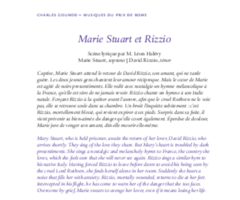Marie Stuart et Rizzio
The libretto for the Prix de Rome cantata of 1837 – Marie Stuart et Rizzio – reflected the prevailing fashion for Gothic style, brought to the fore in Restoration France by the Duchess of Berry. At that time, vignettes of Scotland and England gave people a general idea of the atmospheric scenes described in Romantically poetic terms by the translations of Walter Scott’s novels. This is probably why the candidates’ set text by Léon Halévy conjured up memories of France and past love in a welter of long lyrical passages. Gounod brought out Halévy’s poetic vein in a highly Italianate style when he had the opportunity to write a sweeping melody. It should also be remembered that, during this same period, modern opera seria was featuring a plethora of cantabile roles sung with incomparable legato in the very heart of Paris: at the Théâtre-Italien, where Mesdames Sontag, Pasta, Malibran, Grisi, and Messieurs Lablache, Rubini or Tamburini were at the pinnacle of their success. It is possible that Gounod may have attended the triumphant premiere of Bellini’s I Puritani there several months earlier, in January 1835. The prelude to his cantata is surprising for its sparing orchestration (strings in unison and timpani, with a few abrasive notes from the horn) but also by the vehemence of its initial, particularly breathless, motif. The meeting between Marie and Rizzio—after a brief recitative from the heroine—is the perfect moment to rekindle recollections of the past in remarkable harmonic colours (the keys of D flat major, F# minor, A flat major are heard in quick succession) and melancholy song rhythms. The voices intertwine and swap short vocalises. However, once Rizzio has again departed, Marie begins a recitative in the purest tragic style, which will be transformed by the death of her lover into an aria of heroic courage inherited from ancient lyric tragedy and revisited through the prism of modern grand opera. According to Gérard Condé, quoting Prod’homme and Dandelot (Gounod, sa vie et ses œuvres, 1911), extracts from this cantata may have been performed on 23 November 1837 for the reopening of the Athénée Musical de la Ville de Paris. However, in Le Ménestrel of 3 December 1837, a review reported only that “Monsieur Gounod, who came second in the Institute’s Grand Prix, presented an excerpt of the symphony he has composed and of which the Scherzo promises a true talent for tackling this elevated genre”. In all probability, therefore, Gounod never heard a single bar of the orchestral version of Marie Stuart, which was in fact entirely unpublished.


